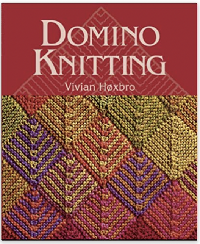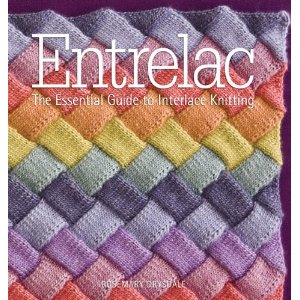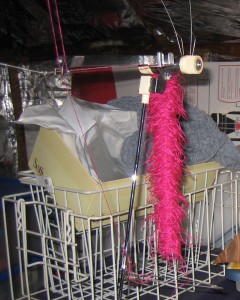The many faces of Rocco: in my 2013 tests in Gimp, the image is 150 pixels wide by 154 pixels high 
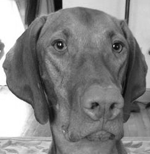 The image is used with the kind permission of Rocco’s owner. I have used this image before, when I posted previously on some ways to reduce colored images to B/W for possible knitting using a Mac computer, please see post on 013/03/14/ color-reduction- conversions-mac-os/. Gimp offers some alternatives to the familiar dithers and is available, free, for both PC and Mac platforms. Tutorial links on Gimp edge detection available online as of May 2019 are listed at bottom of the post.
The image is used with the kind permission of Rocco’s owner. I have used this image before, when I posted previously on some ways to reduce colored images to B/W for possible knitting using a Mac computer, please see post on 013/03/14/ color-reduction- conversions-mac-os/. Gimp offers some alternatives to the familiar dithers and is available, free, for both PC and Mac platforms. Tutorial links on Gimp edge detection available online as of May 2019 are listed at bottom of the post.
Image_Mode_Indexed_ one bit black: immediate result, too dark

Threshold adjustments may not be made in indexed images to alter the above image, so it’s back to greyscale. Reductions to greyscale may be achieved through Image_ Mode_ Greyscale or choosing Colors_Desaturate_OK options. Desaturation offers additional choices
Image_Mode_Greyscale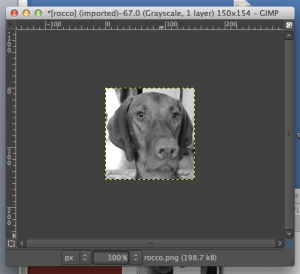 Colors_Desaturate_OK
Colors_Desaturate_OK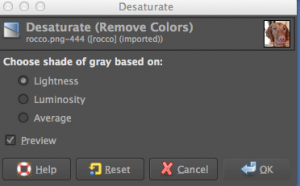 Rocco desaturated, in “knittable portrait size”
Rocco desaturated, in “knittable portrait size” using edge detection and its algorithms
using edge detection and its algorithms Difference of Gaussians
Difference of Gaussians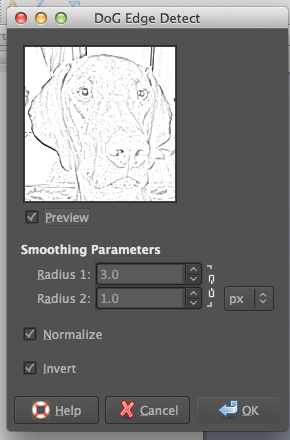
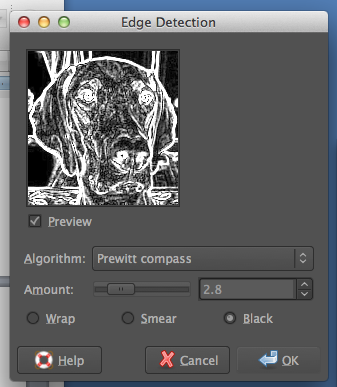

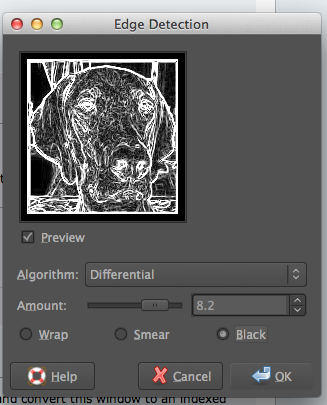

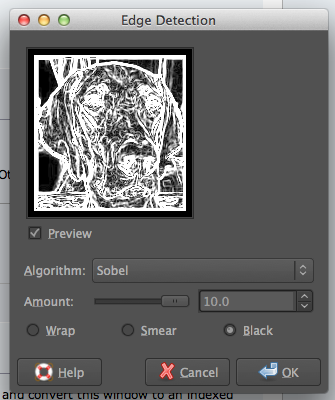
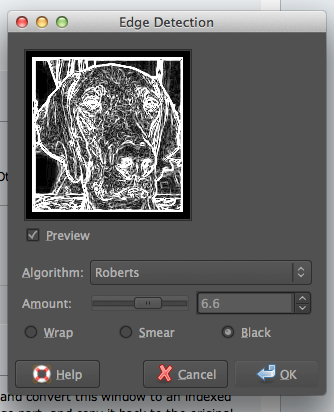 what happens if in addition color_ invert is used with Roberts
what happens if in addition color_ invert is used with Roberts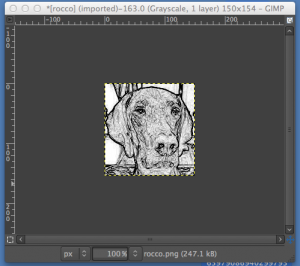 adjusting B/W with Threshold
adjusting B/W with Threshold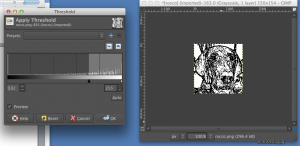 after a bit of “tweaking”
after a bit of “tweaking” 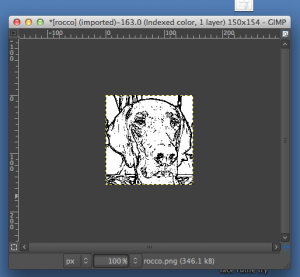 Image_Mode_Indexed, rendering it “knittable in 2 colors”
Image_Mode_Indexed, rendering it “knittable in 2 colors”  getting silly with filling the ground with pattern behind the floating head
getting silly with filling the ground with pattern behind the floating head
2021: the latest, December 2020 updated version of Gimp for Mac OS
Gimp dithering controls easily accessible with mode changes to indexed 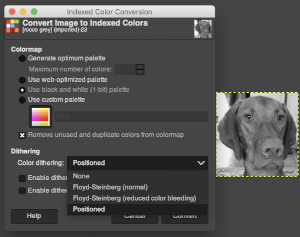 I found I got the best results adjusting the contrast in the original greyscale image prior to changing its mode to indexed and dithering (Floyd_Steinberg, normal)
I found I got the best results adjusting the contrast in the original greyscale image prior to changing its mode to indexed and dithering (Floyd_Steinberg, normal) 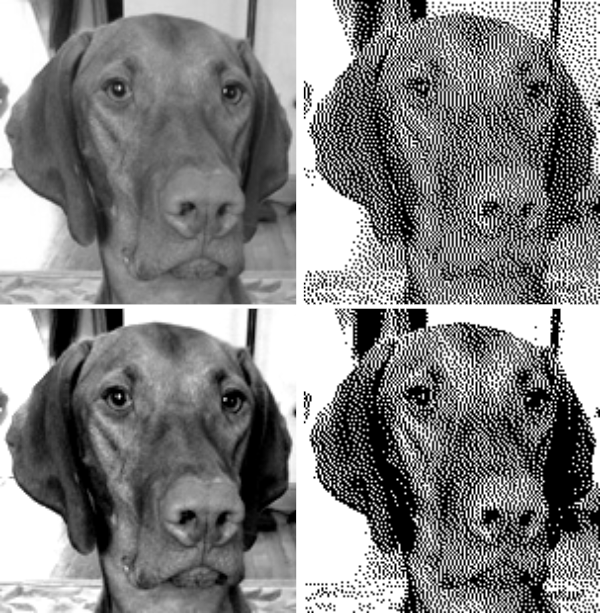 Dithering options in Gimp 2.10 may be found at the bottom of the colors menu
Dithering options in Gimp 2.10 may be found at the bottom of the colors menu 
 This filter can reduce the number of colors in an image by reducing the levels per channel (colors and alpha). Different dithering methods can be specified to counteract quantization-induced banding.
This filter can reduce the number of colors in an image by reducing the levels per channel (colors and alpha). Different dithering methods can be specified to counteract quantization-induced banding.
Presets are common features for many Colors commands.
Red levels, Green levels, Blue levels, and Alpha levels sliders set the number of levels for the respective red, green blue, and alpha channels.
Dithering method: can specify the dithering method to use
None: no dithering will be performed
Floyd Steinberg: the most commonly used method of dithering, and the default for this filter
Bayer: the algorithm is characterized by noticeable cross-hatch patterns in the result
Random, random covariant: use randomization of the pixel values to reduce the number of colors
Arithmetic variants are based on magic numbers and arithmetic
Blue noise variants are sometimes thought to be the least distracting
Random and new seeds are two random dithering methods.
When converting to indexed colors with the image unaltered, and using positioned dithering, the last option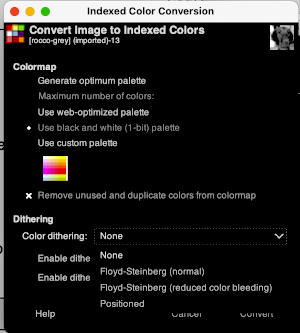
 Hyperdither: options offered
Hyperdither: options offered 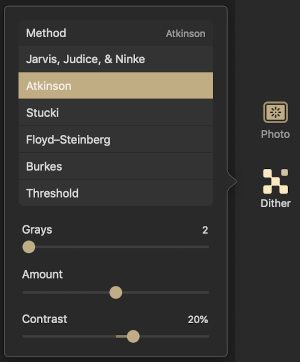 default Jarvis
default Jarvis
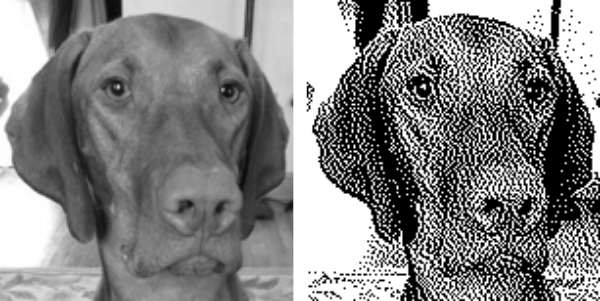 default Stucki
default Stucki
 online, options https://ditherit.com
online, options https://ditherit.com  it is possible to choose from multiple palettes
it is possible to choose from multiple palettes 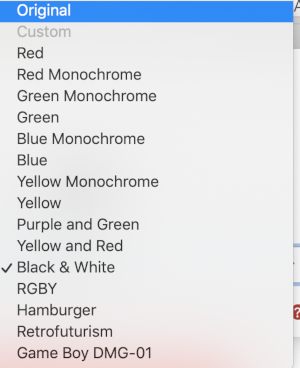 Sierra dither
Sierra dither 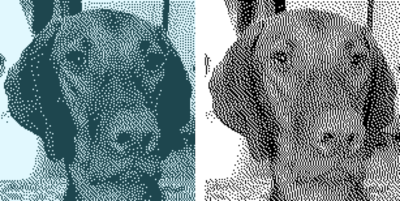
5/4/2019 Other than GIMP: after straightforward load, convert, and save, with no other adjustments, images shown in approximately 150 pixels/sts in width, no significant change results with conversion to color B/W indexed
http://gazs.github.io/canvas-atkinson-dither/
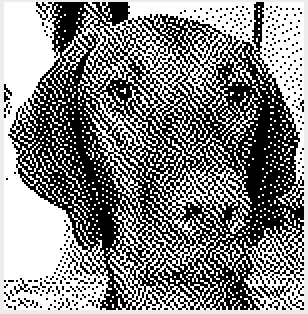 online, default settings https://29a.ch/2016/08/04/ditherlicious-1-bit-image-dithering
online, default settings https://29a.ch/2016/08/04/ditherlicious-1-bit-image-dithering
 Check dithered results, downloaded images may be in RGB Mode. Prior to any knitting, they will need to be converted to B/W indexed.
Check dithered results, downloaded images may be in RGB Mode. Prior to any knitting, they will need to be converted to B/W indexed.
Looking for ways to reduce the noise in dithered images I tried this conversion in XnSketch, using the photocopy effect, beginning with the colored image of Rocco, the results: 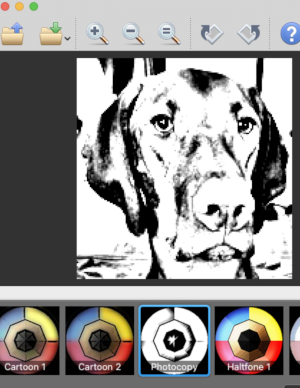 imported the result into Gimp and saved it in indexed 2 color BW and in turn, 3 color indexed mode, no color adjustments, finding the result pleasantly simple
imported the result into Gimp and saved it in indexed 2 color BW and in turn, 3 color indexed mode, no color adjustments, finding the result pleasantly simple 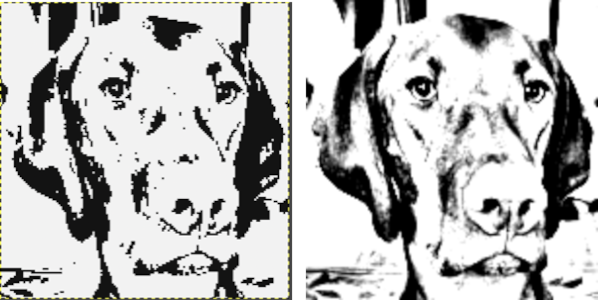 beginning with the greyscale generated image followed by Mode changes in Gimp, indexed 2 color BW, then indexed 3 color, there appear to be very subtle differences with a bit more detail:
beginning with the greyscale generated image followed by Mode changes in Gimp, indexed 2 color BW, then indexed 3 color, there appear to be very subtle differences with a bit more detail: 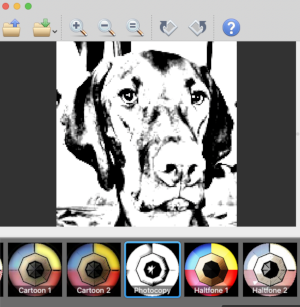
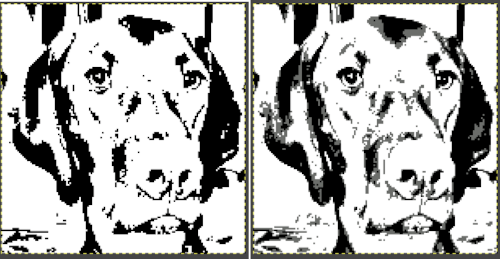 Another online resource with an extensive array of dithering options https://app.dithermark.com. Here are 2 conversions using the app, the images are 2 color B/W. The presence of a third color is an illusion created by the difference in the distribution of BW color pixels, they loaded fine as viewed for knitting in Ayab, and in img2track, once I remembered to change its setting to 2 color knitting from the last used one at 4 colors
Another online resource with an extensive array of dithering options https://app.dithermark.com. Here are 2 conversions using the app, the images are 2 color B/W. The presence of a third color is an illusion created by the difference in the distribution of BW color pixels, they loaded fine as viewed for knitting in Ayab, and in img2track, once I remembered to change its setting to 2 color knitting from the last used one at 4 colors 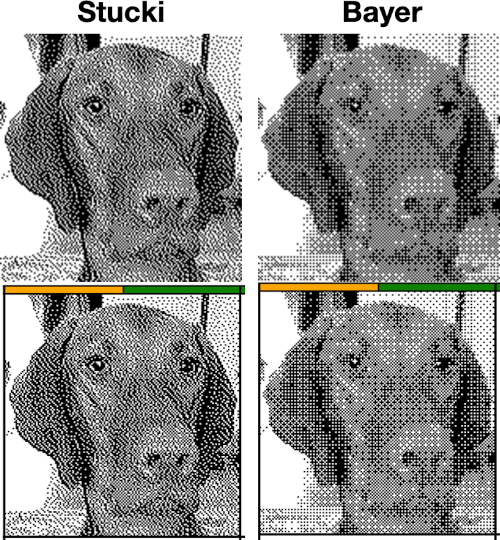 It is possible to reduce images to 4 or 3 colors using the program as well: a slider for color count is used to choose the final number of colors in the reduction. Again, these instances have no added manipulation
It is possible to reduce images to 4 or 3 colors using the program as well: a slider for color count is used to choose the final number of colors in the reduction. Again, these instances have no added manipulation  A series of dithers:
A series of dithers:
 To retain the quality and size of the dithered image, download it, rather than using a screen grab. The software used to separate the chosen dither may alter the result somewhat. I am writing my posts using an iMac M1 with OS 12.0.1. At this point Ayab is not operable, img2track does open images, but in this case, with interesting distortions, and it does not download any files at all.
To retain the quality and size of the dithered image, download it, rather than using a screen grab. The software used to separate the chosen dither may alter the result somewhat. I am writing my posts using an iMac M1 with OS 12.0.1. At this point Ayab is not operable, img2track does open images, but in this case, with interesting distortions, and it does not download any files at all.  Yet another dithering tool, allows one to draw in dithering mode using a variety of patterns and will dither images. In the latter instance, there is no real opportunity to tweak or alter the result
Yet another dithering tool, allows one to draw in dithering mode using a variety of patterns and will dither images. In the latter instance, there is no real opportunity to tweak or alter the result 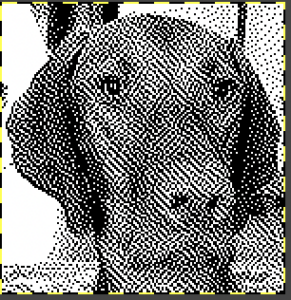 shapes drawn using a few of the large variety of offered patterns:
shapes drawn using a few of the large variety of offered patterns: 
2023 working with pattern fills and removing any background 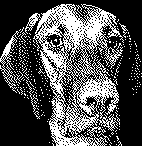
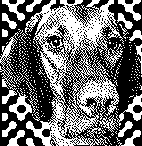
In this instance, a portrait of a dog wearing a sweater image was generated in Midjourney and scaled to 191X195 pixels.
Dithering online apps were used to reduce the colors in instants to 4, 3, and 2.
The greyscale image was also color reduced and dithered in Gimp.
All results were not adjusted further in any way.
Color reductions could be tweaked a bit further prior to actual knitting.
Magnifying the chosen individual result will help visualize the change in resolution quality of the image in the final knit piece. 

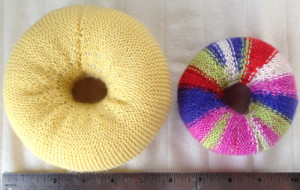
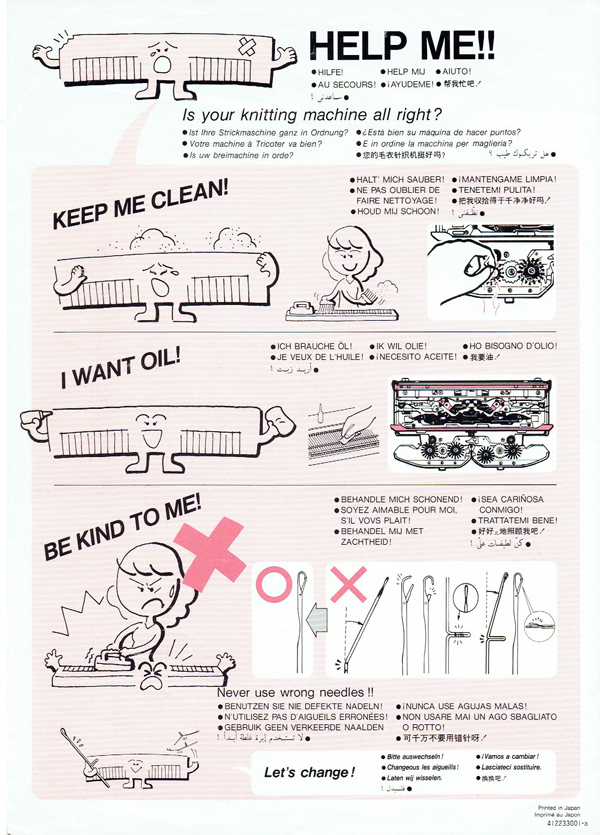
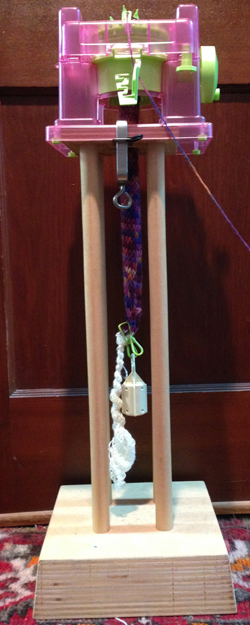
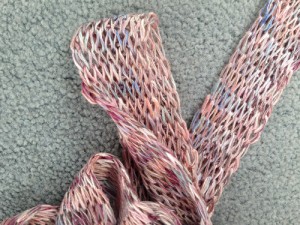



 The image is used with the kind permission of Rocco’s owner. I have used this image before, when I posted previously on some ways to reduce colored images to B/W for possible knitting using a Mac computer, please see post on 013/03/14/ color-reduction- conversions-mac-os/. Gimp offers some alternatives to the familiar dithers and is available, free, for both PC and Mac platforms. Tutorial links on Gimp edge detection available online as of May 2019 are listed at bottom of the post.
The image is used with the kind permission of Rocco’s owner. I have used this image before, when I posted previously on some ways to reduce colored images to B/W for possible knitting using a Mac computer, please see post on 013/03/14/ color-reduction- conversions-mac-os/. Gimp offers some alternatives to the familiar dithers and is available, free, for both PC and Mac platforms. Tutorial links on Gimp edge detection available online as of May 2019 are listed at bottom of the post.



 Difference of Gaussians
Difference of Gaussians






 adjusting B/W with Threshold
adjusting B/W with Threshold after a bit of “tweaking”
after a bit of “tweaking”  Image_Mode_Indexed, rendering it “knittable in 2 colors”
Image_Mode_Indexed, rendering it “knittable in 2 colors” 








 default Stucki
default Stucki




 Check dithered results, downloaded images may be in RGB Mode. Prior to any knitting, they will need to be converted to B/W indexed.
Check dithered results, downloaded images may be in RGB Mode. Prior to any knitting, they will need to be converted to B/W indexed. imported the result into Gimp and saved it in indexed 2 color BW and in turn, 3 color indexed mode, no color adjustments, finding the result pleasantly simple
imported the result into Gimp and saved it in indexed 2 color BW and in turn, 3 color indexed mode, no color adjustments, finding the result pleasantly simple  beginning with the greyscale generated image followed by Mode changes in Gimp, indexed 2 color BW, then indexed 3 color, there appear to be very subtle differences with a bit more detail:
beginning with the greyscale generated image followed by Mode changes in Gimp, indexed 2 color BW, then indexed 3 color, there appear to be very subtle differences with a bit more detail: 

 It is possible to reduce images to 4 or 3 colors using the program as well: a slider for color count is used to choose the final number of colors in the reduction. Again, these instances have no added manipulation
It is possible to reduce images to 4 or 3 colors using the program as well: a slider for color count is used to choose the final number of colors in the reduction. Again, these instances have no added manipulation 
 To retain the quality and size of the dithered image, download it, rather than using a screen grab. The software used to separate the chosen dither may alter the result somewhat. I am writing my posts using an iMac M1 with OS 12.0.1. At this point Ayab is not operable, img2track does open images, but in this case, with interesting distortions, and it does not download any files at all.
To retain the quality and size of the dithered image, download it, rather than using a screen grab. The software used to separate the chosen dither may alter the result somewhat. I am writing my posts using an iMac M1 with OS 12.0.1. At this point Ayab is not operable, img2track does open images, but in this case, with interesting distortions, and it does not download any files at all.  Yet another dithering
Yet another dithering 





